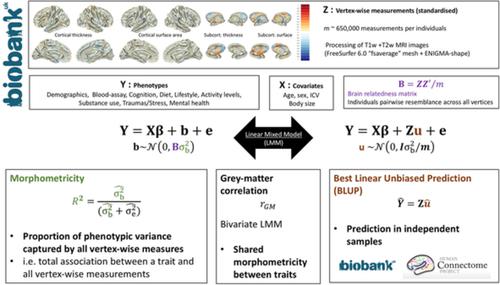当前位置:
X-MOL 学术
›
Hum. Brain Mapp.
›
论文详情
Our official English website, www.x-mol.net, welcomes your
feedback! (Note: you will need to create a separate account there.)
A unified framework for association and prediction from vertex-wise grey-matter structure.
Human Brain Mapping ( IF 3.5 ) Pub Date : 2020-07-20 , DOI: 10.1002/hbm.25109 Baptiste Couvy-Duchesne 1 , Lachlan T Strike 2 , Futao Zhang 1 , Yan Holtz 1, 2 , Zhili Zheng 1, 3 , Kathryn E Kemper 1 , Loic Yengo 1 , Olivier Colliot 4, 5, 6, 7, 8 , Margaret J Wright 2, 9 , Naomi R Wray 1, 2 , Jian Yang 1, 3 , Peter M Visscher 1, 2
Human Brain Mapping ( IF 3.5 ) Pub Date : 2020-07-20 , DOI: 10.1002/hbm.25109 Baptiste Couvy-Duchesne 1 , Lachlan T Strike 2 , Futao Zhang 1 , Yan Holtz 1, 2 , Zhili Zheng 1, 3 , Kathryn E Kemper 1 , Loic Yengo 1 , Olivier Colliot 4, 5, 6, 7, 8 , Margaret J Wright 2, 9 , Naomi R Wray 1, 2 , Jian Yang 1, 3 , Peter M Visscher 1, 2
Affiliation

|
The recent availability of large‐scale neuroimaging cohorts facilitates deeper characterisation of the relationship between phenotypic and brain architecture variation in humans. Here, we investigate the association (previously coined morphometricity) of a phenotype with all 652,283 vertex‐wise measures of cortical and subcortical morphology in a large data set from the UK Biobank (UKB; N = 9,497 for discovery, N = 4,323 for replication) and the Human Connectome Project (N = 1,110). We used a linear mixed model with the brain measures of individuals fitted as random effects with covariance relationships estimated from the imaging data. We tested 167 behavioural, cognitive, psychiatric or lifestyle phenotypes and found significant morphometricity for 58 phenotypes (spanning substance use, blood assay results, education or income level, diet, depression, and cognition domains), 23 of which replicated in the UKB replication set or the HCP. We then extended the model for a bivariate analysis to estimate grey‐matter correlation between phenotypes, which revealed that body size (i.e., height, weight, BMI, waist and hip circumference, body fat percentage) could account for a substantial proportion of the morphometricity (confirmed using a conditional analysis), providing possible insight into previous MRI case–control results for psychiatric disorders where case status is associated with body mass index. Our LMM framework also allowed to predict some of the associated phenotypes from the vertex‐wise measures, in two independent samples. Finally, we demonstrated additional new applications of our approach (a) region of interest (ROI) analysis that retain the vertex‐wise complexity; (b) comparison of the information retained by different MRI processings.
中文翻译:

从顶点灰质结构关联和预测的统一框架。
最近大规模神经成像队列的可用性有助于更深入地表征人类表型和大脑结构变异之间的关系。在这里,我们研究了表型与来自英国生物银行(UKB;N = 9,497 用于发现,N = 4,323 用于复制)的大型数据集中的所有 652,283 个皮质和皮质下形态的顶点测量的关联(以前创造的形态计量学)和人类连接组计划(N= 1,110)。我们使用了一个线性混合模型,将个体的大脑测量值拟合为随机效应,协方差关系从成像数据中估计出来。我们测试了 167 种行为、认知、精神病或生活方式表型,发现 58 种表型(跨越物质使用、血液检测结果、教育或收入水平、饮食、抑郁和认知领域)的显着形态计量学,其中 23 种在 UKB 复制集中复制或 HCP。然后我们扩展模型进行双变量分析以估计表型之间的灰质相关性,这表明体型(即身高、体重、BMI、腰围和臀围、体脂百分比)可以占形态测量的很大一部分(使用条件分析确认),提供对先前 MRI 病例对照结果的可能洞察,其中病例状态与体重指数相关。我们的 LMM 框架还允许在两个独立样本中从顶点测量中预测一些相关的表型。最后,我们展示了我们的方法的其他新应用(a)保留了顶点复杂度的感兴趣区域(ROI)分析;(b) 不同 MRI 处理保留的信息的比较。我们展示了我们方法的其他新应用(a)保留顶点复杂性的感兴趣区域(ROI)分析;(b) 不同 MRI 处理保留的信息的比较。我们展示了我们方法的其他新应用(a)保留顶点复杂性的感兴趣区域(ROI)分析;(b) 不同 MRI 处理保留的信息的比较。
更新日期:2020-09-03
中文翻译:

从顶点灰质结构关联和预测的统一框架。
最近大规模神经成像队列的可用性有助于更深入地表征人类表型和大脑结构变异之间的关系。在这里,我们研究了表型与来自英国生物银行(UKB;N = 9,497 用于发现,N = 4,323 用于复制)的大型数据集中的所有 652,283 个皮质和皮质下形态的顶点测量的关联(以前创造的形态计量学)和人类连接组计划(N= 1,110)。我们使用了一个线性混合模型,将个体的大脑测量值拟合为随机效应,协方差关系从成像数据中估计出来。我们测试了 167 种行为、认知、精神病或生活方式表型,发现 58 种表型(跨越物质使用、血液检测结果、教育或收入水平、饮食、抑郁和认知领域)的显着形态计量学,其中 23 种在 UKB 复制集中复制或 HCP。然后我们扩展模型进行双变量分析以估计表型之间的灰质相关性,这表明体型(即身高、体重、BMI、腰围和臀围、体脂百分比)可以占形态测量的很大一部分(使用条件分析确认),提供对先前 MRI 病例对照结果的可能洞察,其中病例状态与体重指数相关。我们的 LMM 框架还允许在两个独立样本中从顶点测量中预测一些相关的表型。最后,我们展示了我们的方法的其他新应用(a)保留了顶点复杂度的感兴趣区域(ROI)分析;(b) 不同 MRI 处理保留的信息的比较。我们展示了我们方法的其他新应用(a)保留顶点复杂性的感兴趣区域(ROI)分析;(b) 不同 MRI 处理保留的信息的比较。我们展示了我们方法的其他新应用(a)保留顶点复杂性的感兴趣区域(ROI)分析;(b) 不同 MRI 处理保留的信息的比较。











































 京公网安备 11010802027423号
京公网安备 11010802027423号